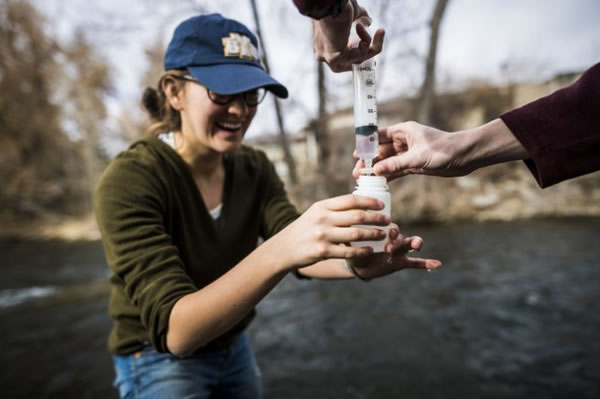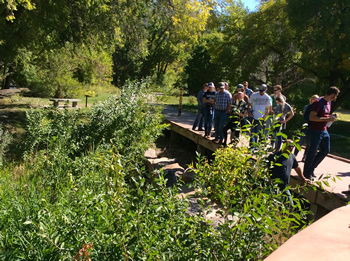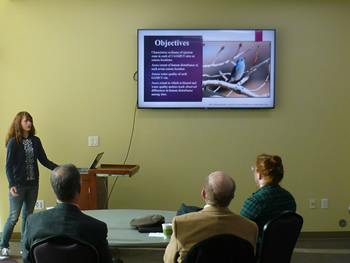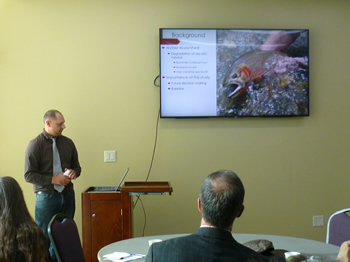Education and Outreach News
March 15, 2018
Citizen Science Project to Improve Utah Lake
iUTAH researcher Erin Jones helped lead a citizen water sampling effort to study and assess rivers and streams that lead into Utah Lake. Aimed at identifying the source of pollutants, this first project involved roughly 150 participants on March 10.
Jones, a teaching assistant for the participating Watershed Ecology class at Brigham Young University, said that around two-thirds of the people involved had contributed to a scientific study before this one. Of the people she talked to, most had some connection to water resources or just a general concern about the environment in general and Utah Lake specifically.
“I think one of my favorite parts about talking with people as they came to pick up their sampling materials or return their filled bottles was to hear about their connection to the watershed,” said Jones. “Many were sampling areas that they were familiar with, but hadn't necessarily ever stopped to think about the water quality there. Other people signed up to go somewhere in the watershed they had never been before, giving them a much deeper connection to place.”
Additional information on the sampling project came from reporter Auburn Remington in a March 7 article in Brigham Young University’s The Daily Universe. “BYU professor Ben Abbott, an ecosystem ecologist and the project director, said the project is focused on sampling by rivers and streams that lead into Utah Lake because they are ‘sensors of ecosystem health. Sampling many places in the river network gives you a high-resolution image, like a computer or a phone screen. If you have more points, you can see more clearly what is going on in a system,’ Abbott said. ‘What’s neat about a river is that it’s a natural organization, and the river has created this tree-like form that extends out into the landscape, and then if we listen to the river or analyze the chemistry of the river, it can tell us what’s happening.’
Abbott said the goal of the project is to identify the non-point sources of nutrients to Utah Lake, or in other words, the nutrients flowing into the lake from things other than pipes. Non-point nutrients include things that flow through the soil, such as fertilizer or contaminated storm water. ‘The other purpose of the study is to get people connected to their watershed, so we appreciate and value what we understand and know,’ Abbott said. ‘If people spend time around Utah Lake and in the rivers flowing to Utah Lake, they’ll realize that this isn’t a trashed or destroyed ecosystem, it’s a beautiful and vibrant environment.’ “
Jones said of those who participated, it would “hopefully increase their awareness and concern about local environmental issues.” The research group hopes to have another event in summer and another class at BYU in the fall to measure seasonal changes in factors such as nutrients. She invites people interested in attending future citizen science samplings of Utah Lake to visit the Utah Lake Research Collaborative website.
Press: The Daily Universe

March 14, 2018
USU's Nancy Huntly Named Ecological Society of America Fellow
iUTAH researcher Nancy Huntly, professor and director of the Ecology Center at Utah State University, have been named a Fellow of the Ecological Society of America. She will be one of 28 honorees formally recognized by the ESA, the world’s largest community of professional ecologists.
A media release provided by USU’s science writer Mary-Ann Muffoletto said that the “ESA lauded Huntly’s ‘foundational research on herbivory, coexistence and human ecology,’ as well as her commitment to and innovation in both science communication and the application of ecological principles to the management of natural resources.
‘Nancy is an outstanding scientist, professor and administrator,’ says Maura Hagan, dean of USU’s College of Science. ‘Her contributions to the establishment and leadership of the USU Climate Adaptation Science program epitomize her innovations in science communication, as well as her scholarly research achievements. Nancy is an exceptional role model to her students and to the young faculty she mentors.’ “
Additionally, “Throughout her career, Huntly has been a key advocate for students and faculty from underrepresented groups. She’s a major contributor of the NSF-funded iUTAH project’s education, outreach and diversity efforts in areas of workforce development and diversity. Huntly also assisted with the establishment of a USU student chapter of SACNAS, the Society for Advancement of Hispanics/Chicanos and Native Americans in Science.
As chair of Science Unwrapped, Huntly oversees a six-person committee and dozens of volunteers, who present community-wide science outreach events, which draw some 500 attendees, ranging in age from preschoolers to senior citizens, to USU’s campus each month during the academic year.”
Press: USU Today | The Herald Journal | Deseret News

January 17, 2018
Cross-Campus Collaborations Bring Classrooms Together
One of the hallmarks of the iUTAH project has been collaboration between campuses across the state. Throughout the past five years, researchers have shared ideas, equipment, and even students. This spirit of sharing has led to the development of a number of cross-institutional courses, including ones involving hydroinformatics, watershed planning and management, and green infrastructure.
The Green Infrastructure course was co-taught for the second time around this last fall at Utah State University and the University of Utah. Ryan Dupont, a professor in civil and environmental engineering at USU, had 14 students in his section of the course, while Sarah Hinners, a research assistant professor in city and metropolitan planning at UU, had 12 students, or a total of 26 students.
The class met on Friday afternoons, at their own respective campuses in technology-linked classrooms, exploring the topic of green infrastructure from planning and engineering to homelessness and social equity, and hearing from a variety of guest speakers. Field trips brought the class together to meet in-person to view and discuss local examples of Green Infrastructure planning and execution in the Ogden area. They also ran parallel field trips in Logan and Salt Lake City, and reported back to one another.
When asked about the benefits of bring the course together, Ryan Dupont said that “content and discussions we have had in the joint offering course are richer, than when I am able to offer the course myself with only engineering students making up the class roster. I find it very valuable to have students, faculty and guest lecturers with different perspectives on this subject presenting and discussion issues on GI design and implementation.”
As part of the USU section, students completed a class project to enter EPA's Campus RainWorks Challenge, for which student teams design an innovative green infrastructure project for their campus that effectively manages stormwater pollution while benefitting the campus community and the environment. At UU, four students worked with the Jordan River Commission and a state legislator to produce background research and recommendations for a proposed Jordan River State Park.
Both Dupont and Hinners said that interdisciplinary engagement has been a very positive aspect of their involvement in iUTAH, one that they hope continues into the future. “I don’t have an available co-instructor from engineering down here, and I really can’t cover that topic area well myself, but it’s critical to the topic of green infrastructure,” said Hinners. “I really love having a diversity of backgrounds, experience and expertise in the classroom.”
Other courses brought together by the iUTAH project that use this model of cross-campus collaboration include Integrated River Basin Watershed Planning and Management and Water Resources Planning taught by David Roseberg from USU and Steven Burian from UU. In 2012, a Hydroinformatics graduate course was started taught by Jeff Horsburgh and David Rosenberg from USU, along with Steve Burian from UU, and Dan Ames from BYU. The course was offered simultaneously at the three locations via interactive video conferencing and covered information on how to use computer software and hardware to collect, manage, and analyze large amounts of water-related data. The course has been offered annually since 2012, with a one-time expansion in 2014 to include faculty and students from University of Wyoming, and University of Virginia.
Syllabi for the Fall 2017 Green Infrastructure course:


December 20, 2017
WSU Symposium Showcases Student Research
Amid the hectic schedule of finals week, some Weber State University students made time in their busy schedules to present their research findings from participation in iUTAH’s summer iFellows undergraduate research fellowship program and faculty Research Catalyst Grants (RCG). The event was co-hosted by Carla Trentelman, associate professor of Sociology, and Dan Bedford, professor of Geography and WSU honors program director, and attended by students, faculty, administrators, and friends of iUTAH.
This year, two WSU undergraduates, Maggie England and Mike Fowles, were part of a cohort of 15 students that participated in the 11-week summer research experience. During that time, they were actively involved in iUTAH fieldwork, research, and analysis. Working with faculty and student mentors, these students learned about the challenges and solutions needed to sustain the state’s water supply over the next few decades and the environmental impacts that we have on bird species, and aquatic habitats in local watersheds.
Students presenting research at the WSU symposium include Maggie England, Mike Fowles, and Rebekah Holt. Past participant attendees included Cynthia Elliot, 2016 iFellow, William Soule, Summer Institute mentor, and Kassandra Sqrow, who participated in both an RCG and as a Summer Institute mentor.
Rebekah Holt worked with faculty mentor Bridget Hilbig, assistant professor of botany at WSU, on a RCG project focused on enhancing soil complexity to improve sustainable urban agriculture. They constructed a rooftop garden, adding Arbuscular mycorrhizal fungi (AMF) native to Utah to soil and measured growth responses in pepper plants. While the AMF plants grew better, challenges with the location and the growing boxes limited the growth of viable crops. Future research will involve changing the plants from peppers to parsley, and making adjustments to the boxes and watering schedule.
“Ever since iUTAH began, our colleagues at Weber State have been terrific supporters of undergraduate research,” said Mark Brunson, iUTAH Education, Outreach and Diversity director and professor in the Department of Environment & Society at Utah State University. “Our research faculty have greatly enjoyed working with Weber students, and the work they’ve done has made a real contribution.”
In the five years that WSU has partnered with iUTAH, 41 students have been involved in undergraduate research, including 14 iFellows, 7 Summer Research Institute mentors, and 24 student RCG researchers.


November 21, 2017
Growing a Water-Wise Citizenry
Part of iUTAH’s aim is to provide learning opportunities and foster experiences that promote water education for students of all ages. We have worked with our museum partners to create both stationary installations and traveling exhibits reaching well over 400,000 people at 412 public outreach events in the past five years. This number is still growing since many of these displays are still in active use.


